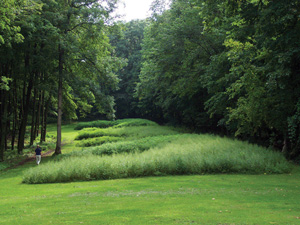
Effigy Mounds National Monument
Comprising over 2,500 acres in northeastern Iowa, Effigy Mounds National Monument has preserved more than 200 earthen mounds created by Native American tribes from about 500 B.C. until the 18th century, the time of European settlement in the area. Many of the mysterious mounds are effigies (images) of animals – most commonly bears and birds – and are considered sacred to numerous area Indian tribes.
The meaning or purpose of the effigy mounds has not been conclusively determined. Certain Indian legends suggest the mounds are ceremonial or religious sites. Some archeologists and historians believe the mounds were territorial markers or tribal boundaries. Others think the mounds delineated choice gathering and hunting grounds, or honored spirits for providing the fertility and bounty of the area.
Effigy Mounds National Monument is located in one of the most picturesque sections of the Upper Mississippi River Valley, featuring forests, bluffs, tallgrass prairies, wetlands and rivers. The area is home to a wide diversity of flora and fauna which helped shape the lifestyle and beliefs of the mound building peoples. The monument’s most famous feature is the Marching Bear Group, consisting of ten bear-shaped mounds and stretching nearly a quarter of a mile along the top of a bluff overlooking the Upper Mississippi River.
More information on Effigy Mounds National Monument.
